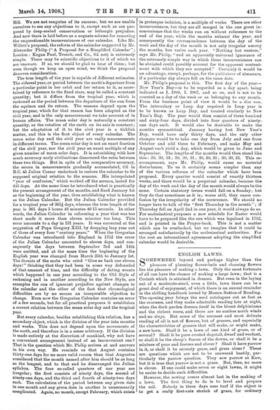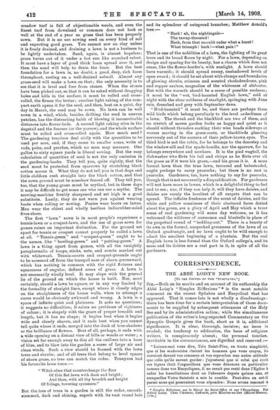ENGLISH LAWNS.
SOMEWHERE beyond and perhaps higher than the pleasure of planning flower-beds and choosing flowers lies the pleasure of making a lawn. Only the most fortunate of all can have the chance of making a large lawn; that is a Corinth which is attained in dreams. But even in the laying out of a moderate-sized, even a little, lawn there can be a great deal of enjoyment, of which there is an annual reminder in the shilling handbook issued by Messrs. Sutton of Reading. The opening year brings the seed catalogues out as fast as the crocuses, and they make admirable reading late at night, when the dark garden dresses itself in the bluest delphiniums and the richest roses, and there are no sunless north winds and no slugs. But some of the serenest and most delicate reading of all is not of flowers, but of grasses, and especially the characteristics of grasses that will make, or might make, a new lawn. Shall it be a lawn of one kind of grass, or of several ? Shall it be pure crested dogstail, dwarf and verdant, or shall it be the sheep's fescue of the downs, or shall it be a mixture of pons and fescues and clover ? Shall it have yarrow in it, or shall it be severely grass, and grass alone ? These are questions which are not to be answered hastily, par- ticularly the yarrow question. They sow yarrow at Kew, but it is true that yarrow is not a grass. But, then, no more is clover. If one could make seven or eight lawns, it might be easier to decide such difficulties.
However, the sowing comes almost last in the making of a lawn. The first thing to do is to level and prepare the soil. Nobody in these days uses turf if the object is to get a really first-rate stretch of grass, for ordinary
meadow turf is full of objectionable weeds, and even the finest turf from downland or common does not look as well at the end of a year as grass that has been properly sown. But it is no use sowing seed on every kind of soil and expecting good grass. You cannot sow on clay unless it is freely drained, and draining a lawn is not a business to be lightly undertaken. Sand, again, is almost hopeless; grass burns out of it under a hot sun like scorched velvet. It must have a layer of good thick loam spread over it, and then the sand will help to drain the loam. But the best foundation for a lawn is, no doubt, a good, deep, rich loam throughout, resting on a well-drained subsoil. Almost any grass-seed will make a lawn on that ; the only necessity is to see that it is level and free from stones. When the stones have been picked out, so that it can be raked without dragging boles and hills in the surface, it must be rolled and cross- rolled, the firmer the better; another light raking of the com- pact earth opens it for the seed, and then, best on a quiet, dry day in March, the seed may be sown. No lawn can be well sown in a wind, which, besides drifting the seed in uneven patches, has the distracting habit of blowing it inconceivable distances into flower-beds. A second light raking stirs in the dogstail and the fescues (or the yarrow), and the whole surface must be rolled and cross-rolled again. How much seed ? The gardening treatises deal airily with the quantities to be used per acre, and, if they come to smaller areas, write of rods, poles, and perches, which no man may measure. One gallon to sixty square yards is liberal sowing. But the easy calculation of quantities of seed is not the only omission in the gardening-books. They tell you, quite rightly, that the seed must be protected from sparrows by stretching black cotton across it. What they do not tell you is that dogs and little children rush straight into the black cotton, and that the sown ground must be somehow fenced off. They tell you, too, that the young grass must be scythed, but in these days it may be difficult to get some one who can use a scythe. The mowing-machine freshly sharpened and set high is a good substitute. Lastly, they do not warn you against wearing boots when rolling or sowing. Ponies wear boots on lawns. Men wear the oldest and wholly heelless indiarubber-soled fives-shoes.
The first "lawn" sown is in most people's experience a tennis-lawn or a croquet-lawn, and the use of grass sown for games raises an important distinction. For the ground set apart for tennis or croquet cannot properly be called a lawn at all. " Tennis-green" and " croquet-green " ought to be the names, like " bowling-green " and " putting-green." A lawn is a thing apart from games, with all the unsightly paraphernalia of hoops, sticks, nets, and courts marked out with whitewash. Tennis-courts and croquet-grounds ought to be screened off from the tranquil ease of shorn greensward, which has nothing in common with the rigid flatness and squareness of angular, defined areas of grass. A lawn is not necessarily wholly level. It may slope with the general lie of the ground on which the house is built. Nor, most certainly, should a lawn be square, or in any way limited by the formality of straight lines, except where it closely edges on the straightness of the house walls, when to attempt a curve would be obviously awkward and wrong. A lawn is a space of infinite quiet and plainness. It asks no questions; it suggests no difficulties; it raises no problems of rightness of colour ; it is shapely with the grace of proper breadth and length, but it has no shape; it begins best when it begins wide and closely shaven, and it ends best when you cannot tell quite where it ends, merged into the dusk of tree-shadows or the brilliance of flowers. Best of all, perhaps, it ends with a wide opening on a distant view of hills or woods or water ; a vision set far enough away to dim all the outlines into a haze of blue, and to blow into the garden a sense of large air and clean winds. Such a view should be framed with the lawn trees and shrubs; and of all trees that belong to level spaces of shorn grass, no tree can match the cedar. Tennyson had his favourite lawn trees:- " Witch-elms that counterchange the floor Of this flat lawn with dusk and bright ; And thou, with all thy breadth and height Of foliage, towering sycamore."
But the tree of trees in a garden is still the cedar, smooth- stemmed, dark and shining, superb with its vast round bole and its splendour of outspread branches ; Matthew Arnold's tree
" Hark ! ah, the nightingale—
The tawny-throated!
Hark, from that moonlit cedar what a burst!
What triumph ! hark 1—what pain !"
That is one of the nobilities of a lawn, the lighting of its great trees and its broad floors by night. For a lawn, depending on design and spacing for its beauty, has a charm which does not cease, like the flower-border's, with sunlight. A lawn should have warmth ; it should spread sunny, unehadowed levels of open sward ; it should be set about with clumps and boundaries of glowing shrubs, crimson and scented rhododendrons, pink and copper azaleas, magnolias of the whiteness of alabaster. But with the warmth should be a sense of possible coolness ; it must be the "wet, bird-haunted English lawn," cold at night with the clear coldness of starlight, springing with June rain, drenched and grey with September dews.
"Bird-haunted" it must be, and there are perhaps three wild birds which belong peculiarly to the level orderliness of a lawn. The thrush and the blackbird are two of them, and no stretch of mown garden looks as happy and quiet as it should without thrushes cocking their wise heads sideways at worms moving in the grass-roots, or blackbirds glancing nervously out of the corners of their yellow-brown eyes. The third bird is not the robin, for he belongs to the doorstep and the window-sill and the spade-handle, nor the sparrow, for he belongs everywhere and nowhere. It is the pied wagtail, the dishwasher who flirts his tail and chirps as he flirts over all the grass as if it were his grass,—and his grass it is. A more formal lawn than the true lawn, terraced and balustraded, ought perhaps to carry peacocks; but there is no rest iu peacocks. Gardeners, too, have nothing to say for peacocks, though that is not necessarily a disqualification. For gardeners will not have moss in lawns, which is a delightful thing to feel and to see ; nor, if they can help it, will they have daisies, and daisies are surely the loveliest of all carpets that can be spread. The infinite freshness of the scent of daisies, and the white and yellow sunniness of their clustered faces dotted about the green, are a glory of April and May which a truer sense of real gardening will some day welcome, as it has welcomed the wildness of anemones and bluebells in place of the perpetual round of " bedding-out." There is a beauty of its own in the formal, unspecked greenness of the lawn of an Oxford quadrangle, and no lawn ought to be wild enough to admit the smallest beginning of a plantain. But the real English lawn is less formal than the Oxford college's, and its moss and its daisies are a real part in it, in spite of all the gardeners.











































 Previous page
Previous page